|
|
|
 |

 |
 |
Nuclear Reactors
InTech, 2012, 350 p.
This book presents a comprehensive review of studies in nuclear reactors technology from authors across the globe. Topics discussed in this compilation include: thermal hydraulic investigation of TRIGA type research reactor, materials testing reactor and high temperature gas-cooled reactor; the use of radiogenic lead recovered from ores as a coolant for fast reactors; decay heat in reactors and spent-fuel pools; present status of two-phase flow studies in reactor components; thermal
|
aspects of conventional and alternative fuels in supercritical water?cooled reactor; two-phase flow coolant behavior in boiling water reactors under earthquake condition; simulation of nuclear reactors core; fuel life control in light-water reactors; methods for monitoring and controlling power in nuclear reactors; structural materials modeling for the next generation of nuclear reactors; application of the results of finite group theory in reactor physics; and the usability of vermiculite as a shield for nuclear reactor.
Extraído de:
http://www.intechopen.com/books/show/title/nuclear-reactors
|
 |
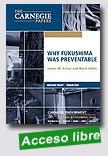 |
Why Fukushima was Preventable
Carnegie Endowment for International Peace, March 2012, 50 p.
Public sentiment in many states has turned against nuclear energy following the March 2011 accident at Japan’s Fukushima Daiichi Nuclear Power Station. The large quantity of radioactive material released has caused significant human suffering and rendered large stretches of land uninhabitable. The cleanup operation will take decades and may cost hundreds of billions of dollars.
|
The Fukushima accident was, however, preventable. Had the plant’s owner, Tokyo Electric Power Company (TEPCO), and Japan’s regulator, the Nuclear and Industrial Safety Agency (NISA), followed international best practices and standards, it is conceivable that they would have predicted the possibility of the plant being struck by a massive tsunami. The plant would have withstood the tsunami had its design previously been upgraded in accordance with state-of-the-art safety approaches.
The methods used by TEPCO and NISA to assess the risk from tsunamis lagged behind international standards in at least three important respects:
Insufficient attention was paid to evidence of large tsunamis inundating the region surrounding the plant about once every thousand years.
Computer modeling of the tsunami threat was inadequate. Most importantly, preliminary simulations conducted in 2008 that suggested the tsunami risk to the plant had been seriously underestimated were not followed up and were only reported to NISA on March 7, 2011.
NISA failed to review simulations conducted by TEPCO and to foster the development of appropriate computer modeling tools.
Extraído de:
http://carnegieendowment.org/2012/03/06/why-fukushima-was-preventable/a0i7#
|
 |
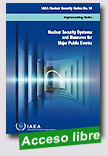 |
Nuclear Security Systems and Measures for Major Public Events
IAEA Nuclear Security, 2012, 56 p.
The purpose of this publication is to provide structured guidance to States that may be hosting a major public event. It describes nuclear security systems and measures that may need to be established or enforced to enhance the effectiveness
and efficiency of the overall security for the event. This publication is intended for policy makers, event organizers, law enforcement agencies, emergency services and other relevant responsible and technical support organizations.
|
Extraído de:
http://www-pub.iaea.org/MTCD/Publications/PDF/Pub1546_web.pdf
|
 |
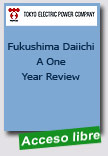 |
First of all, we deeply apologize to all residents of Fukushima Prefecture as well as broader society for the concern and anxiety that has arisen on account of the accident at Fukushima Daiichi Nuclear Power Station (NPS) due to the March 11, 2011 Tohoku - Pacific Ocean Earthquake.
The accident at Fukushima Daiichi NPS was caused by the loss of reactor core cooling functions and the prolonged simultaneous loss of all Alternate Current (AC) and Direct
|
Current (DC) power due to the 13 meter-height tsunami brought about by the massive M9.0 earthquake.
What followed after was the extremely serious accident in which a series of explosions occurred at the reactor buildings and radioactive materials were released into the atmosphere and ocean.
Since then, we have been making a concerted effort to achieve a full recovery while receiving support from the government, relevant domestic and overseas organizations and manufacturers. As of December 2011, we have achieved conditions equivalent to a cold shutdown. This is the state where the inside reactor temperatures of Units 1 through 3 have decreased to approximately below 100 degrees C and the release of radioactive materials has been significantly suppressed and is being kept under control.
Currently, efforts to steadily cool down the reactors, control radioactive emissions into the atmosphere, and stop all radiation leakage into the ocean remain ongoing.
Hereafter, per the Mid-and-Long-term Plan prepared in conjunction with the government that was released in late December 2011, we will move forward with such activities including our primary mission to decommission Units 1 through 4.
In order to enable the evacuees to return home as soon as possible and restore peace of mind to all the citizens of Japan, we will do our best to maintain the cool state of the reactors and prevent further radioactive emissions.
In the following content, we will take a look back upon the tumultuous year that transpired at Fukushima Daiichi NPS and go over the many challenges we faced and how we dealt with them.
Extraído de:
http://www.tepco.co.jp/en/nu/fukushima-np/review/index-e.html
|
 |
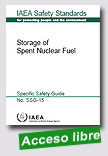 |
Storage of Spent Nuclear Fuel
IAEA Safety Standards Series, 2012, 110 p.
This Safety Guide provides recommendations and guidance on the storage of spent nuclear fuel. It covers all types of storage facilities and all types of spent fuel from nuclear power plants and research reactors. It takes into consideration the longer storage periods that have become necessary owing to delays in the development of disposal facilities and the decrease in reprocessing activities. It also considers developments associated with nuclear fuel, such as higher enrichment, mixed |
oxide fuels and higher burnup. The Safety Guide is not intended to cover the storage of spent fuel if this is part of the operation of a nuclear power plant or spent fuel reprocessing facility. Guidance is provided on all stages for spent fuel storage facilities, from planning through siting and design to operation and decommissioning, and in particular retrieval of spent fuel. Contents: 1. Introduction; 2. Protection of human health and the environment; 3. Roles and responsibilities; 4. Management system; 5. Safety case and safety assessment; 6. General safety considerations for storage of spent fuel. Appendix I: Specific safety considerations for wet or dry storage of spent fuel; Appendix II: Conditions for specific types of fuel and additional considerations; Annex: I: Short term and long term storage; Annex II: Operational and safety considerations for wet and dry spent fuel storage facilities; Annex III: Examples of sections of operating procedures for a spent fuel storage facility; Annex IV: Site conditions, processes and events for consideration in a safety assessment (external human induced phenomena); Annex V: Site conditions, processes and events for consideration in a safety assessment (external natural phenomena); Annex VI: Site conditions, processes and events for consideration in a safety assessment (external human induced phenomena); Annex VII: Postulated initiating events for consideration in a safety assessment (internal phenomena).
Extraído de:
http://www-pub.iaea.org/books/IAEABooks/8532/Storage-of-Spent-Nuclear-Fuel |
 |
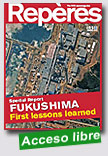 |
Repères - Fukushima Special Report - First Lessons Learned
Institut de Radioprotection et de Sûreté Nucléaire (IRSN - FR), January 2012, 24 p.
One year after the accident, IRSN propose an English translation of a special issue of its newsmagazine, Repères, who is focused on the accident and on the first lessons drawn by IRSN regarding nuclear safety.
The first part revisits the accident and its aftermath, and the mobilization of IRSN during the crisis. The second part looks at the assessments launched in 2011 to check the conformity of |
French nuclear facilities. It also addresses research that could better predict the fate of radionuclides released from Fukushima, as well as to improve the monitoring and radiation protection in France.
Em inglês | Em francês
Extraído de:
http://www.irsn.fr/EN/publications/thematic/fukushima/Pages/overview.aspx
|
 |
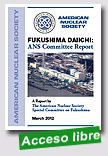
|
Fukushima Daiichi: ANS Committee Report
American Nuclear Society Special Committee on Fukushima, March 2012, 48 p.
The Tohoku earthquake, which occurred at 2:46 p.m. (Japan time) on Friday, March 11, 2011, on the east coast of northern Japan, is believed to be one of the largest earthquakes in recorded history. Following the earthquake on Friday afternoon, the nuclear power plants at the Fukushima Daiichi, Fukushima Daini, Higashidori, Onagawa, and Tokai Daini nuclear power stations (NPSs) were affected, and emergency systems were |
activated. The earthquake caused a tsunami, which hit the east coast of Japan and caused a loss of all on-site and off-site power at the Fukushima Daiichi NPS, leaving it without any emergency power. The resultant damage to fuel, reactor, and containment caused a release of radioactive materials to the region surrounding the NPS. Although the United States was not directly affected, our nuclear power industry will take important lessons from this accident.
The American Nuclear Society (ANS) formed a special committee, The American Nuclear Society Special Committee on Fukushima (the Committee), to examine the Fukushima Daiichi accident. The Committee was charged to provide a clear and concise explanation of the accident events, health physics, and accident cleanup, as well as safety-related issues that emerged. The Committee also evaluated actions that ANS should consider to better communicate with the public during a nuclear event the Committee used publically available source materials from the Japanese industry and government as well as reports from those entities to the international community, as indicated in the sections “References” and “Bibliography.” The Committee views do not reflect any major inconsistencies regarding accident events, health physics, and accident cleanup. The safety-related issues identified by the Committee are consistent with what has been noted in the reports already issued from many regulatory agencies. Finally, the Committee focused on risk communication and crisis communication as major issues that ANS as a professional society needs to address in the future.
The Committee worked from May 2011 to December 2011. Because the accident forensics, accident cleanup, and associated off-site health effects are ongoing, the Committee will continue to update the detailed accident-related information at the ANS Web site (http://fukushima.ans.org/) as new measurements, facts, insights, and regulatory developments are gained. An embedded topical meeting, International Meeting on Severe Accident Assessment and Management: Lessons Learned from Fukushima Daiichi, will be held as part of the ANS Winter Meeting in November 2012.
Extraído de:
http://fukushima.ans.org/report/Fukushima_report.pdf
|
 |
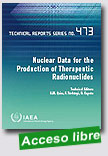 |
Nuclear Data for the Production of Therapeutic Radionuclides
IAEA Technical Reports Series, 2012, 382 p.
This publication reports the results of an IAEA coordinated research project on nuclear data for the production of therapeutic radionuclides. The aim was to provide standardized data for the production of radionuclides for therapeutic purposes, embracing current and possible future needs. Experimental data compilations, theoretical calculations and evaluations were carried out for each of the reactions. The recommendations for production of both established and emerging radionuclides are
|
discussed, and the analysis carried out to produce the recommended data is also presented. The improved quality of the nuclear data will make reactor and accelerator production of therapeutic radionuclides much more efficient, and should also enhance their quality through improved purity of the product. The current publication comprises new evaluated data for both reactor and accelerator production of therapeutic radionuclides based on more than 50 different production reactions.
Extraído de:
http://www-pub.iaea.org/books/IAEABooks/8522/Nuclear-Data-for-the-Production-of-Therapeutic-Radionuclides
|
 |
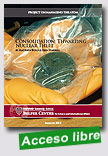 |
Consolidation: Thwarting Nuclear Theft
Belfer Center for Science and International Affairs, March 2012, 64 p.
At the first nuclear security summit in April 2010, the assembled leaders agreed on the goal of securing all vulnerable nuclear material worldwide within four years, including consolidating plutonium and highly enriched uranium (HEU) to fewer locations and minimizing the use of HEU “where technically and economically feasible.” Reducing the number of buildings and sites where nuclear weapons and weapons-usable nuclear
|
material exist is a key element of preventing nuclear theft and nuclear terrorism, as the only way to completely eliminate the risk that nuclear material will be stolen from a particular location is to remove the material itself. States can achieve more effective nuclear security at lower cost if they have fewer places with nuclear weapons or weapons-usable nuclear material to protect.
The fundamental goal must be to reduce the number of sites and transports as far and as quickly as possible, and provide highly effective security for those that remain. Over time, the civil use of HEU should be phased out, and HEU should be eliminated from all civil sites. This paper outlines the efforts the international community is already making to meet these objectives, and recommends a range of next steps. Today, nuclear weapons or their essential ingredients exist in hundreds of buildings and bunkers in dozens of countries, with widely varying levels of security. Fortunately, an array of national and international efforts to move nuclear weapons and weapons-usable nuclear material to fewer locations have been underway for years, and have made major progress. Since the end of the Cold War, nuclear weapons have been removed from many countries and scores of nuclear weapon sites have been eliminated. Twenty countries have eliminated all the weapons-usable nuclear material on their soil – six of them since President Obama called for a four-year effort to secure nuclear materials in April 2009. All weapons-usable nuclear material has been removed from dozens of other sites around the world. Some 180 research reactors that once used HEU fuel have either shut down or converted to using low-enriched uranium that cannot be used in a nuclear bomb. The world is more secure as a result.
But there is much more to be done. There are stocks of material and types of facilities that are not yet targeted for consolidation, and a range of political, bureaucratic, technical, and financial barriers to be overcome. There are potentially effective policy tools that have not yet been fully utilized. This paper (a) discusses how to set priorities among different stocks to be consolidated; (b) describes the scope and progress of existing consolidation efforts; and (c) suggests steps to complement and extend the existing programs. Our discussion of the next steps for consolidation will fall into two categories: covering additional stocks and facilities that are not yet effectively addressed, and using additional policy approaches to strengthen the effort.
Extraído de:
http://belfercenter.ksg.harvard.edu/publication/21818/consolidation.html
|
 |
|
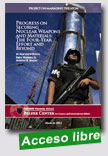
|
Progress on Securing Nuclear Weapons and Materials: the Four-Year Effort and Beyond
Belfer Center for Science and International Affairs, March 2012, 40 p.
On the eve of the Nuclear Security Summit in Seoul, South Korea, a new study finds that an international initiative to secure all vulnerable nuclear stockpiles within four years has reduced the dangers posed by many of the world’s highest-risk nuclear stockpiles. But the new analysis, by researchers with the Project on Managing the Atom at Harvard Kennedy School's Belfer Center, also concludes that much will remain to be done to ensure that all nuclear weapons and material are secure when the current four-year effort comes to an end. |
|
|
|
|
|
|
